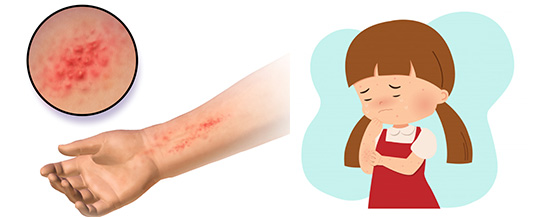How to Care for Your Child with Contact Dermatitis or Eczema
This leaflet will provide you with information about contact dermatitis or eczema causes, symptoms, diagnosis, treatment and home care advice.

What is contact dermatitis or eczema?
Eczema is the name of a group of conditions that causes the skin to become dry and irritated
Sometimes the terms "dermatitis" and "eczema" are frequently used interchangeably.
Contact dermatitis is an inflammation of the skin that is caused by contact between the skin and:
- Irritant (a substance that damages the outer layer of the skin) such as chemical, soap, skin product, or detergent.
- Allergen (a substance that causes an allergic reaction) such as fragrance, metals (such as nickel), chemicals, hair dye, or plants. The reaction normally happens a few hours or days from exposure to irritant or allergen
What are the symptoms of contact dermatitis or eczema?
Symptoms may include
- Redness,
- Dryness,
- Fissures (small cracks)
- Itching, this sometimes can be very intense
- Red raised rash in severe cases. This rash may cause blisters
- Swelling on the affected area
How is contact dermatitis or eczema diagnosed?
The doctor will ask few questions about your child's health and examine your child. Your child's doctor will decide if further investigation or blood tests are required.
No special testing is required in the emergency department. If your child's doctor feels that further testing is required, your child will be referred to a specialist clinic.
How is contact dermatitis or eczema treated?
In case of irritant contact dermatitis: The main aim of treatment is to restore the normal skin, barrier and protect the skin from future injury
In case of allergic contact, dermatitis usually gets better within two to four weeks or more after the allergen is removed
In some cases, some medicines may be used:
- Steroid ointment or cream: these are most effective when applied and covered with a barrier like plastic wrap or petroleum jelly (Vaseline)
- Emollient – moisturisers can be applied to the skin to stop it from becoming dry
- Soothing lotions such as calamine lotion can provide relief in mild cases.
Home care advice
- Try to notice what your child comes into contact with that might help to identify and stop all exposure to the allergen
- Bath your child in warm water. Use unscented soap
- Use wet dressing over the affected area (the garment is soaked with water and then wrung out). Wet dressings should be changed every eight hours.
- Give your child medicines recommended by your doctor as directed.
- Wash the rash with mild soap and rinse completely.
- Encourage your child not to scratch the skin because this can make the rash worse and lead to a skin infection.
What to avoid?
Avoid using any topical antihistamines because they can cause contact dermatitis.
Triggers like:
- Harsh soap and perfumes,
- Very dry air,
- Cigarette smoke,
- Fabrics like wool and polyester

